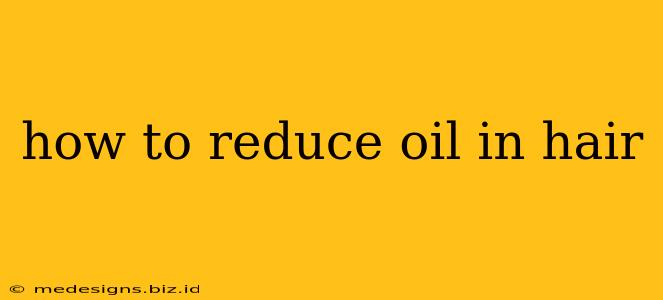Oily hair? You're not alone! Many people struggle with excess oil production, leading to greasy strands, limp locks, and a generally unhappy hair day. But don't despair! This comprehensive guide will provide you with effective strategies to reduce oil in your hair and achieve that enviable, healthy shine.
Understanding Oily Hair: The Root of the Problem
Before we delve into solutions, let's understand why your hair gets oily in the first place. Your scalp has sebaceous glands that produce sebum, a natural oil that keeps your hair moisturized and protected. However, overproduction of sebum can lead to excessive oiliness. Several factors can contribute to this:
- Genetics: Some people are simply genetically predisposed to produce more sebum.
- Hormones: Hormonal fluctuations, particularly during puberty, pregnancy, or menopause, can significantly impact sebum production.
- Diet: A diet high in processed foods, sugary drinks, and unhealthy fats can contribute to an oily scalp.
- Hair Products: Using heavy, oil-based products can clog pores and exacerbate oiliness.
- Stress: Believe it or not, stress can also stimulate sebum production.
- Over-Washing: Ironically, washing your hair too often can actually stimulate your scalp to produce more oil.
Effective Ways to Reduce Oil in Your Hair
Now that we understand the causes, let's explore practical solutions to tame that oily hair:
1. Wash Your Hair Regularly (But Not Too Often!)
Finding the right washing frequency is key. Washing too often can strip your scalp of its natural oils, leading to overproduction. Aim for washing every other day or every two to three days, depending on your hair type and oil production levels.
2. Choose the Right Shampoo
Opt for a clarifying shampoo or a shampoo specifically formulated for oily hair. These shampoos effectively remove excess oil without stripping your hair of its essential moisture. Look for shampoos containing ingredients like:
- Salicylic acid: Helps to exfoliate the scalp and unclog pores.
- Tea tree oil: Possesses natural antiseptic and anti-inflammatory properties.
- Zinc pyrithione: Helps to regulate sebum production.
3. Condition Strategically
While you need to cleanse your scalp, avoid applying conditioner directly to your scalp. Focus on applying conditioner only to the ends of your hair, where it's most needed. This prevents adding extra oil to your scalp.
4. Rinse with Apple Cider Vinegar (ACV)
Apple cider vinegar can help balance your scalp's pH levels and reduce oil production. Dilute apple cider vinegar with water (a ratio of 1:1 is a good starting point) and use it as a final rinse after shampooing. Note: Be mindful of the smell, and always dilute it properly.
5. Dry Your Hair Properly
Avoid roughly towel-drying your hair, as this can stimulate oil production. Gently pat your hair dry with a soft towel. Allowing your hair to air dry is also a great option, although it's important to choose a well-ventilated area.
6. Style Smartly
Avoid hairstyles that trap heat and oil close to your scalp, such as tight braids or ponytails. Opt for loose styles that allow for better air circulation.
7. Dietary Adjustments
Consider incorporating foods that support healthy hair and scalp into your diet. Focus on consuming a balanced diet rich in fruits, vegetables, lean proteins, and healthy fats.
8. Manage Stress
Easier said than done, we know! However, finding healthy ways to manage stress, such as yoga, meditation, or spending time in nature, can have a positive impact on your overall health and may reduce oil production.
9. Consider Professional Help
If you've tried these methods and are still struggling with excessively oily hair, consider consulting a dermatologist or trichologist. They can identify any underlying medical conditions and recommend specific treatments.
Maintaining Healthy, Oil-Free Hair: Long-Term Strategies
Reducing oil in your hair is a journey, not a destination. By adopting these strategies consistently, you'll be well on your way to achieving a healthier, less oily scalp and more manageable hair. Remember to be patient and persistent – results will come with time and consistent effort. Remember to adjust your routine based on your hair’s response.
